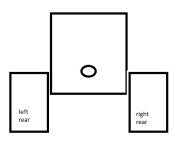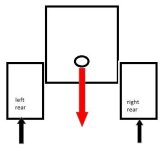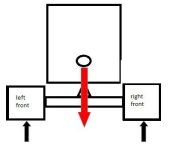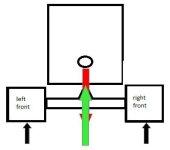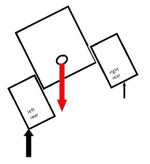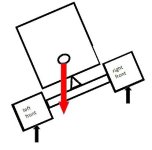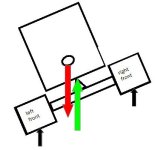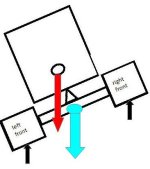GolfAddict
Veteran Member
Perhaps a good way to help visualize is what someone mentioned - a three wheeled tractor (two rear wheels that are far apart, one front wheel in the middle.)
Park this three wheeled tractor sideways on a very steep hill. Start adding weights up on the tractor over the back wheels, let's say on the tractor seat, until it starts to tip the tractor. Now remove all the weights.
Take the weights and start adding them above the front center wheel at the same height as the tractor seat. You reach the tipping point with less of the weights - you don't have that wheel sticking way out down hill like you had on the back.
Remove all the weights. Put the loader on and park the three wheeled tractor in the exact same spot, leaving the loader slightly off the ground. Start adding the weights over the front wheel again. You will not have to add as many weights to get to the tipping point this time, due to the loader already adding weight to the front above that wheel.
On our tractors, with the front having two wheels a ways apart just like the back, it is easy to forget that it is still just like a single wheel in the middle. The fronts are on a pivot in the middle - think of the pivot as being that single front wheel. You will tip just as easily on the pivot as on a single wheel all the way up until you hit the pivot stop. Then you have to hope you don't have enough momentum built up or anything else to keep you from going right on over...
Park this three wheeled tractor sideways on a very steep hill. Start adding weights up on the tractor over the back wheels, let's say on the tractor seat, until it starts to tip the tractor. Now remove all the weights.
Take the weights and start adding them above the front center wheel at the same height as the tractor seat. You reach the tipping point with less of the weights - you don't have that wheel sticking way out down hill like you had on the back.
Remove all the weights. Put the loader on and park the three wheeled tractor in the exact same spot, leaving the loader slightly off the ground. Start adding the weights over the front wheel again. You will not have to add as many weights to get to the tipping point this time, due to the loader already adding weight to the front above that wheel.
On our tractors, with the front having two wheels a ways apart just like the back, it is easy to forget that it is still just like a single wheel in the middle. The fronts are on a pivot in the middle - think of the pivot as being that single front wheel. You will tip just as easily on the pivot as on a single wheel all the way up until you hit the pivot stop. Then you have to hope you don't have enough momentum built up or anything else to keep you from going right on over...
